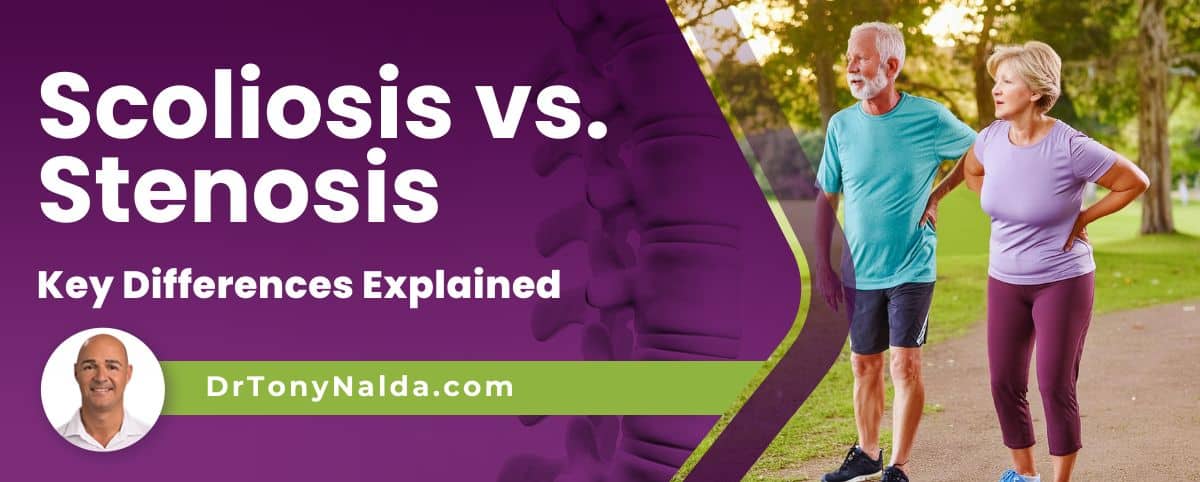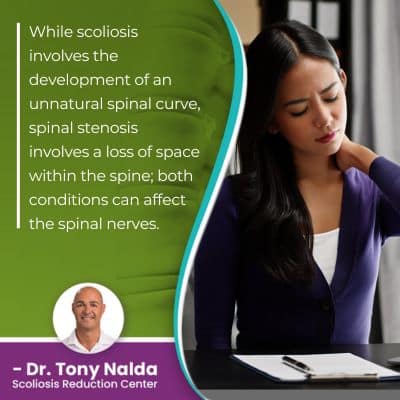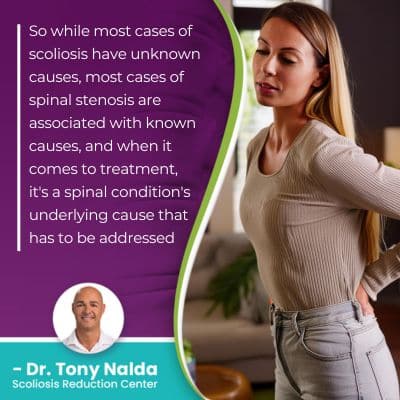Scoliosis vs. Stenosis: Key Differences Explained

The spine performs many important roles, and there are a number of conditions, injuries, and issues it's vulnerable to developing. Not only does the spine allow us to stand upright and move flexibly, it also protects important organs and works with the brain to form the central nervous system (CNS).
Scoliosis is the development of an unnatural sideways-bending and twisting spinal curve, and spinal stenosis is a loss of space within the spinal canal, and this affects the spinal cord and nerve function; both conditions can cause nerve compression, but do so in different ways.
Before discussing the differences between scoliosis and stenosis, let's start with some basic spinal anatomy to better understand how spinal conditions can disrupt its function.
Table of Contents
Anatomy of a Healthy Spine
A healthy spine is curved at each of its three main sections: the cervical spine (neck), the thoracic spine (middle/upper back), and the lumbar spine (lower back).
A healthy spine has its curves in place because they make the spine stronger, more flexible, and better able to handle mechanical stress, and this helps it function optimally.
The spine consists of vertebrae (bones) stacked on top of one another in a straight and neutral alignment, and adjacent vertebrae are separated by an intervertebral disc, and these discs are key to spinal health and function; they give the spine structure (adjacent vertebral bodies attach to the disc in between), they combine forces to make the spine flexible, they provide cushioning to prevent friction during movement, and act as the spine's shock absorbers.
The vertebral column has a hollowing opening that makes up the spinal canal through which the spinal cord passes and functions within.
The spinal cord is a bundle of 31 pairs of spinal nerves; remember, the brain and spine work together to form the body's central nervous system, and the central nervous system is a complex communication network that facilitates brain-body communication.
Because the central nervous system is involved in the function of virtually every working part and system within the body, spinal conditions can cause a wide range of symptoms and effects felt throughout the body, and not just in and around the spine.
Now that we have a basic idea of the spine's structure and individual parts, let's take a look at the two spinal conditions in question: scoliosis vs stenosis.
What is Scoliosis?
Scoliosis is a highly-prevalent structural spinal condition that affects all ages and is the leading spinal deformity among school-aged children.
Scoliosis involves the development of an unnatural sideways-bending and rotating spinal curve, and as a progressive condition, the nature of scoliosis is to get worse over time, and it's growth that triggers progression.
Scoliosis progressing means the size of the unnatural spinal curve is increasing over time, along with the condition's uneven forces, and their effects.
Scoliosis effects that will increase over time involve postural changes (the main effect in children), disruptions to balance, coordination, and how a person walks, and in adults, a prominent lean to one side is common, along with varying levels of back pain and pain that radiates into the extremities due to nerve compression.
Scoliosis severity ranges from mild scoliosis to moderate scoliosis and severe to very severe scoliosis cases, and as a progressive condition, virtually all cases are going to get worse at some point, so treatment is about managing on ongoing condition because although incurable, scoliosis can be highly treatable.
There are never treatment guarantees, but particularly when scoliosis is diagnosed and treated early, there are fewer limits to what can be achieved.
Scoliosis causes the spine to bend unnaturally to the side and also twist, and this rotational component makes scoliosis a 3-dimensional condition, and the complex nature of scoliosis necessitates the complete customization of effective treatment plans.
As scoliosis progression is triggered by growth, childhood scoliosis should always be taken seriously, particularly as the condition gets more difficult to treat the more it progresses.
What is Stenosis?
 While scoliosis involves the development of an unnatural spinal curve, spinal stenosis involves a loss of space within the spine; both conditions can affect the spinal nerves.
While scoliosis involves the development of an unnatural spinal curve, spinal stenosis involves a loss of space within the spine; both conditions can affect the spinal nerves.
Scoliosis becomes compressive once skeletal maturity has been reached, and compression means uneven pressure, and this doesn't just affect the spine, but also its surrounding muscles and nerves; stenosis also exposes spinal nerves to uneven pressure.
When there is a loss of space within the spine, its individual structures and nerves within are affected, and if a spinal section experiences a narrowing of the spinal canal, this means its nerve roots within can become irritated, compressed, and impinged to the point of disrupting the nerve's function.
If a nerve experiences compression it can cause symptoms felt where the uneven pressure originates or anywhere along a nerve's pathway.
Spinal stenosis most commonly affects the cervical and lumbar spinal sections, while scoliosis most often develops in the thoracic spine: the largest spinal section.
Scoliosis Causes vs Stenosis Causes
While both spinal conditions can affect any spinal section, and both cause nerve involvement, their causes differ significantly.
When it comes to scoliosis, causation depends on the type in question; there are 4 main types of scoliosis, and they are idiopathic scoliosis, neuromuscular scoliosis, degenerative scoliosis, and congenital scoliosis.
Idiopathic scoliosis accounts for approximately 80 percent of known cases, and the remaining 20 percent are associated with known causes: neuromuscular conditions like spina bifida, muscular dystrophy, and cerebral palsy that cause a disconnect between the brain, the spine, the muscles and/or connective tissues that support the spine, age-related spinal degeneration (degenerative disc disease), and a malformed spine that develops in utero.
Common causes of stenosis can involve a herniated disc, bone spurs, and thickened ligaments.
When a disc herniates, its inner nucleus has pushed through a tear in its outer annulus, and this means that the inner disc material is leaking out and encroaching on space within the spine, taking up room that once was used by other spinal parts, like the spinal nerves.
If a herniated disc is pushing against the spinal canal, the nerve roots close by will have less room to function optimally within, and this can cause them to become pinched, irritated, and disrupt their function.
Bone spurs are bony projections on the edge of bones, or where bones meet, in the joints, and these bony projections shouldn't be there so are taking up space within the spine, and when this happens, it can cause compression of the spinal canal and its nerves within.
It's not just the spine that has to maintain its healthy curves and alignment, but also the spine's surrounding muscles and ligaments that provide important spinal support and stabilization.
The ligaments are like strong ropes that give the vertebrae structure by holding them together, but if one becomes thickened over time, it can become rigid and start to bulge outwards, and this bulging can push it into the spinal canal and cause a loss of space within.
 So while most cases of scoliosis have unknown causes, most cases of spinal stenosis are associated with known causes, and when it comes to treatment, it's a spinal condition's underlying cause that has to be addressed.
So while most cases of scoliosis have unknown causes, most cases of spinal stenosis are associated with known causes, and when it comes to treatment, it's a spinal condition's underlying cause that has to be addressed.
Conclusion
So what are the similarities between scoliosis and stenosis? Both are spinal conditions whose symptoms tend to get worse over time, especially if left untreated.
Both conditions can affect the body in a number of ways as they both introduce uneven forces to the spine and its surroundings, and both can cause compression and impingement of the spinal nerves within the spinal canal.
While there are some similarities between the two spinal conditions, there are more significant differences; while scoliosis involves the development of an unnatural sideways bending and rotating spinal curve, stenosis involves a loss of space within the spinal canal.
While the cause of most cases of scoliosis is unknown, stenosis is caused by disc issues, bone spurs, thickened ligaments, and/or spinal injury and trauma.
Scoliosis also tends to cause more noticeable symptoms, particularly in children for whom the main effect is postural deviation (uneven shoulders, uneven hips, the development of a rib cage arch).
Scoliosis is also known to cause changes to balance, coordination, and gait, and in adults for whom the condition is compressive, pain is the most-noticeable condition effect.
In many cases of spinal stenosis, symptoms are subtle and it's not uncommon that spinal stenosis doesn't cause noticeable symptoms and is diagnosed accidentally while patients are having X-rays done for other reasons.
It's important to understand that both spinal conditions need to be addressed; if either are left untreated, their symptoms are likely to get worse, and nerve function is likely to become more compromised over time.
Dr. Tony Nalda
DOCTOR OF CHIROPRACTIC
After receiving an undergraduate degree in psychology and his Doctorate of Chiropractic from Life University, Dr. Nalda settled in Celebration, Florida and proceeded to build one of Central Florida’s most successful chiropractic clinics.
His experience with patients suffering from scoliosis, and the confusion and frustration they faced, led him to seek a specialty in scoliosis care. In 2006 he completed his Intensive Care Certification from CLEAR Institute, a leading scoliosis educational and certification center.
About Dr. Tony Nalda
 Ready to explore scoliosis treatment? Contact Us Now
Ready to explore scoliosis treatment? Contact Us Now





